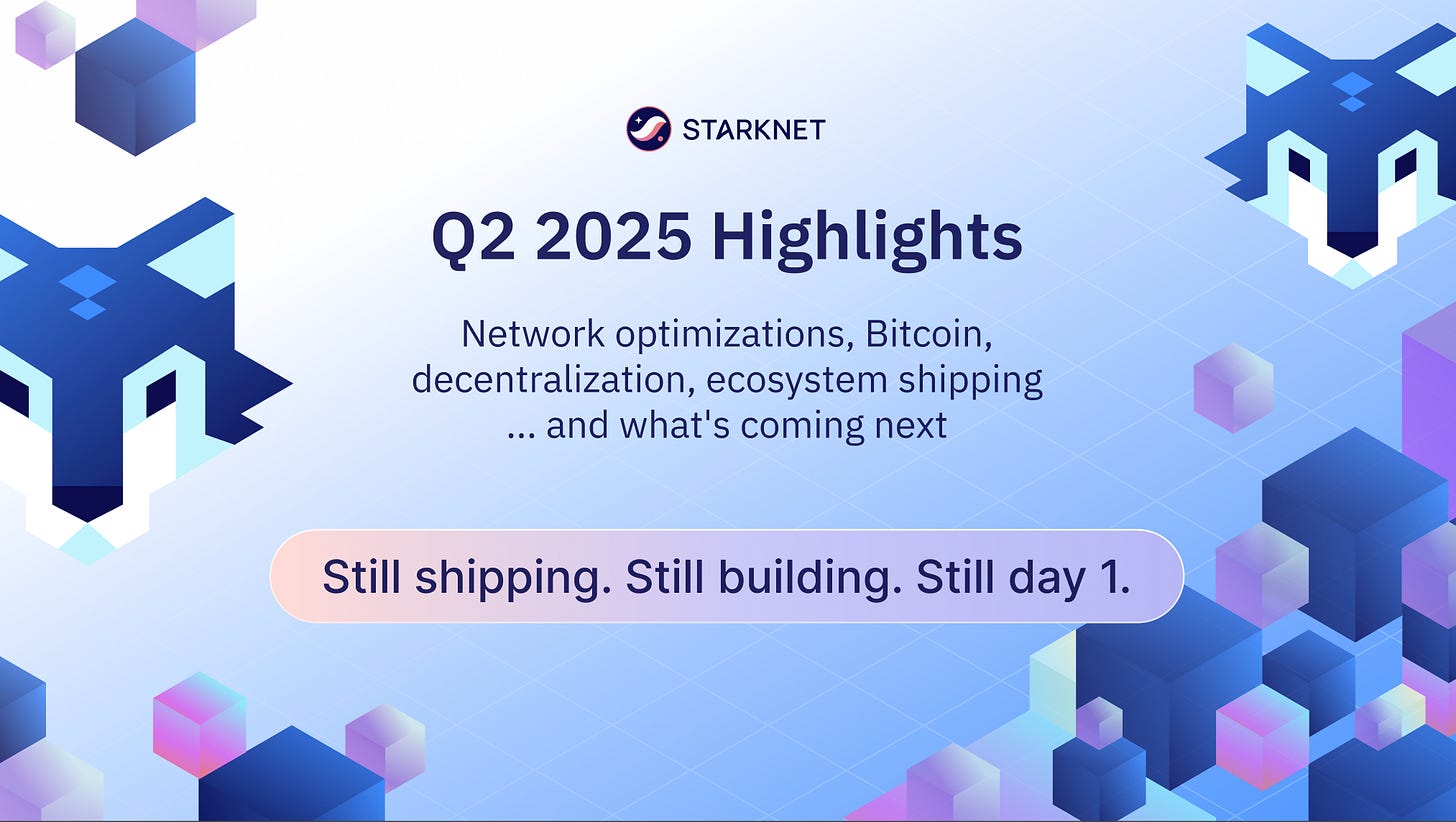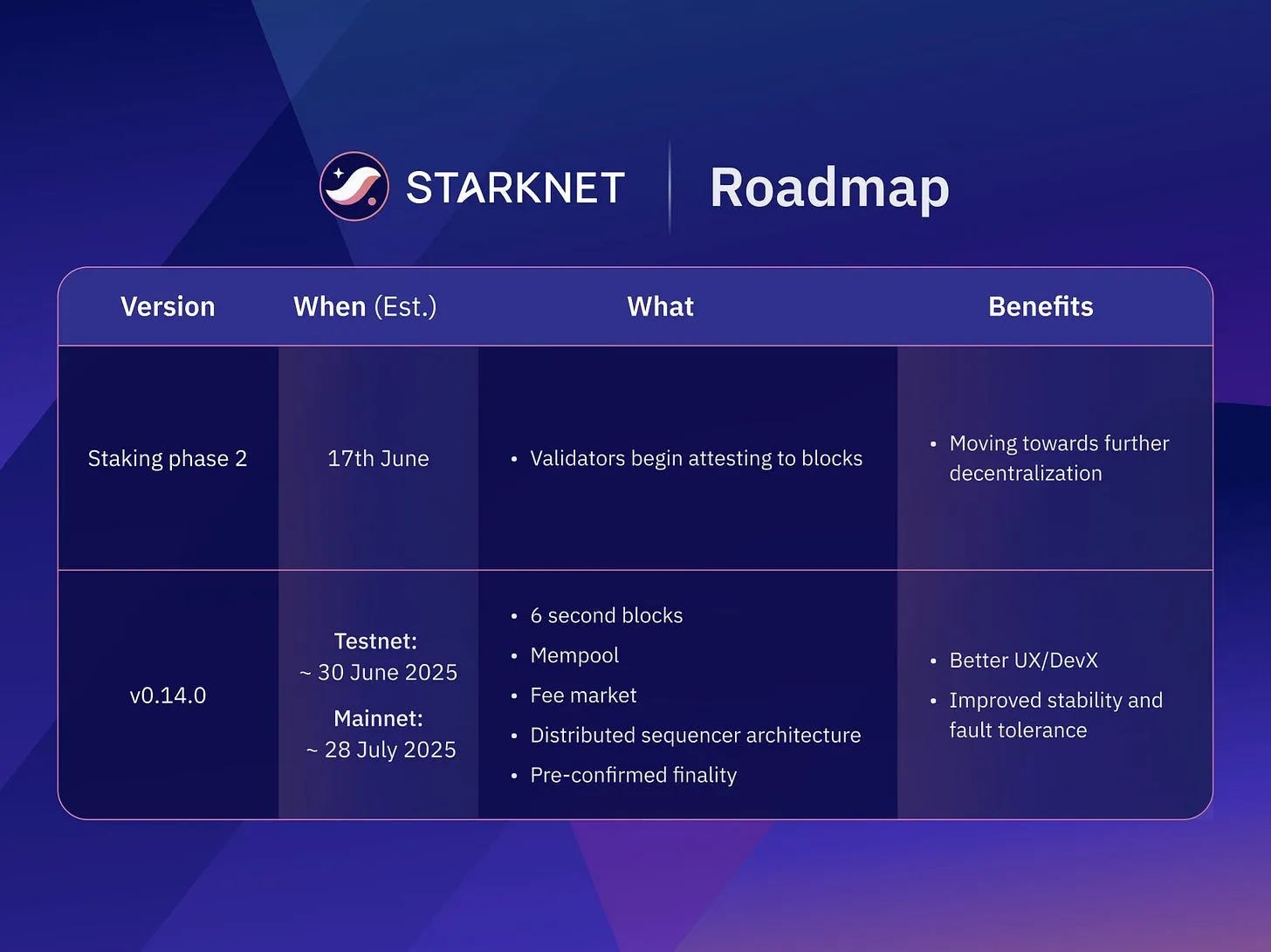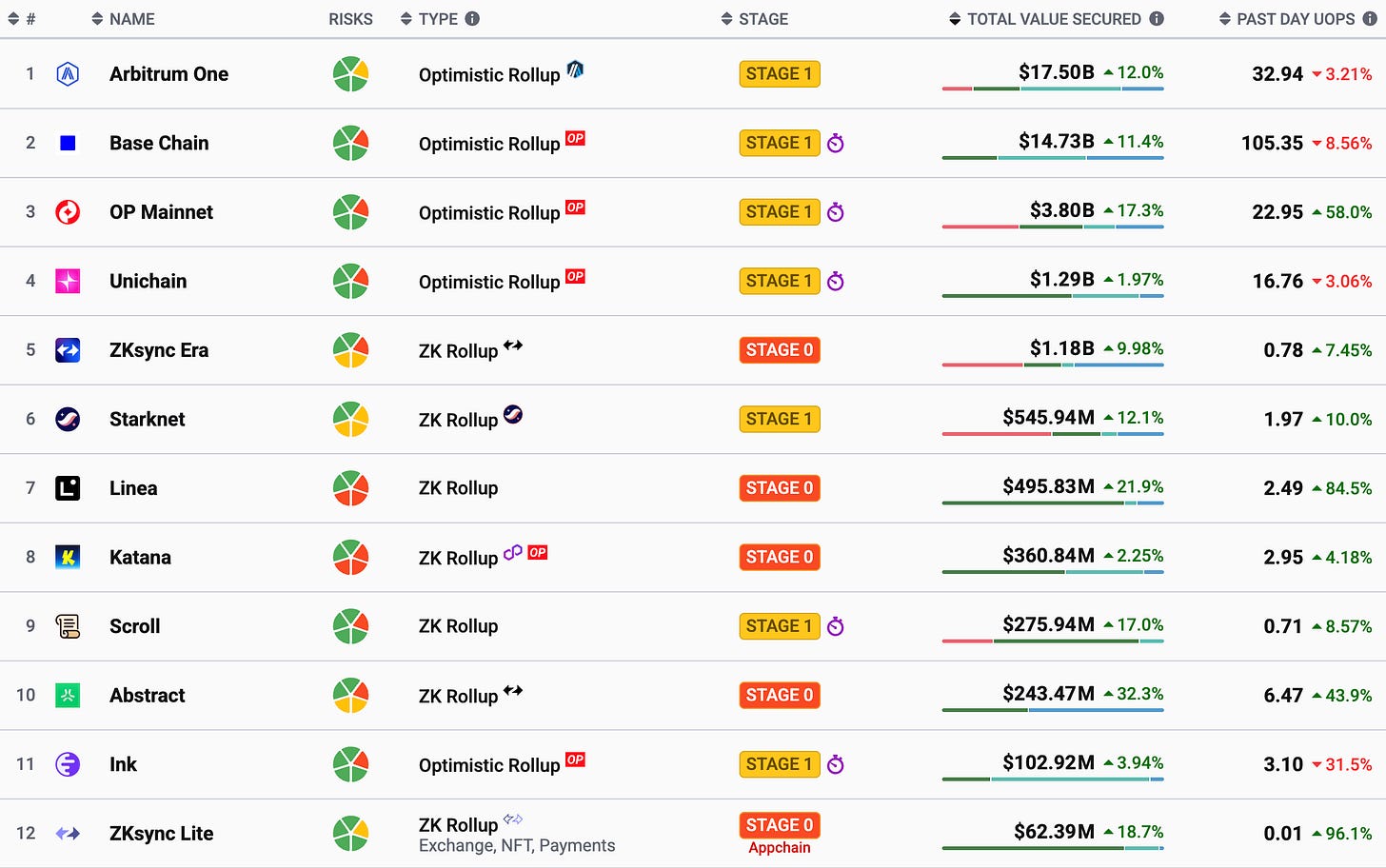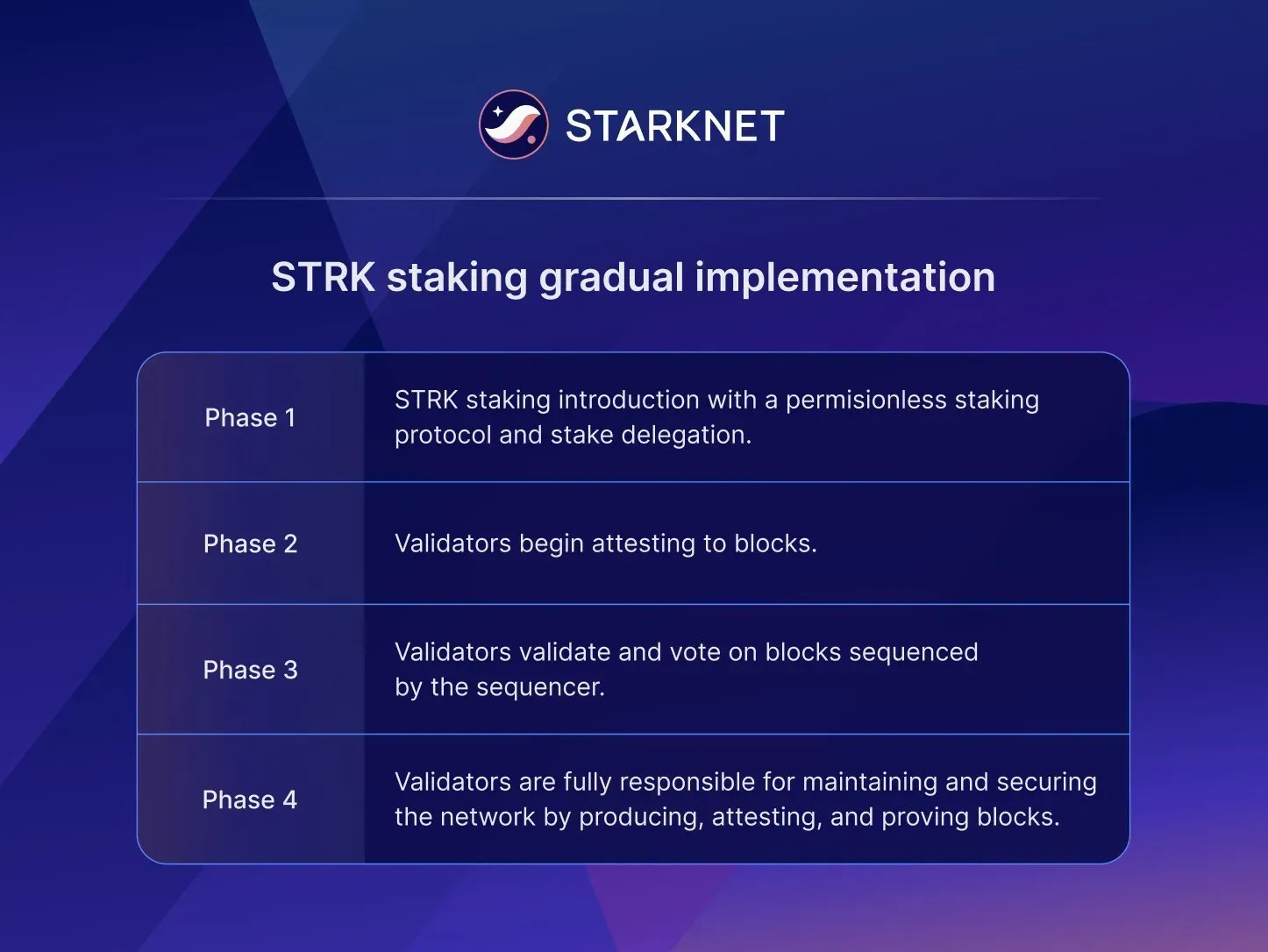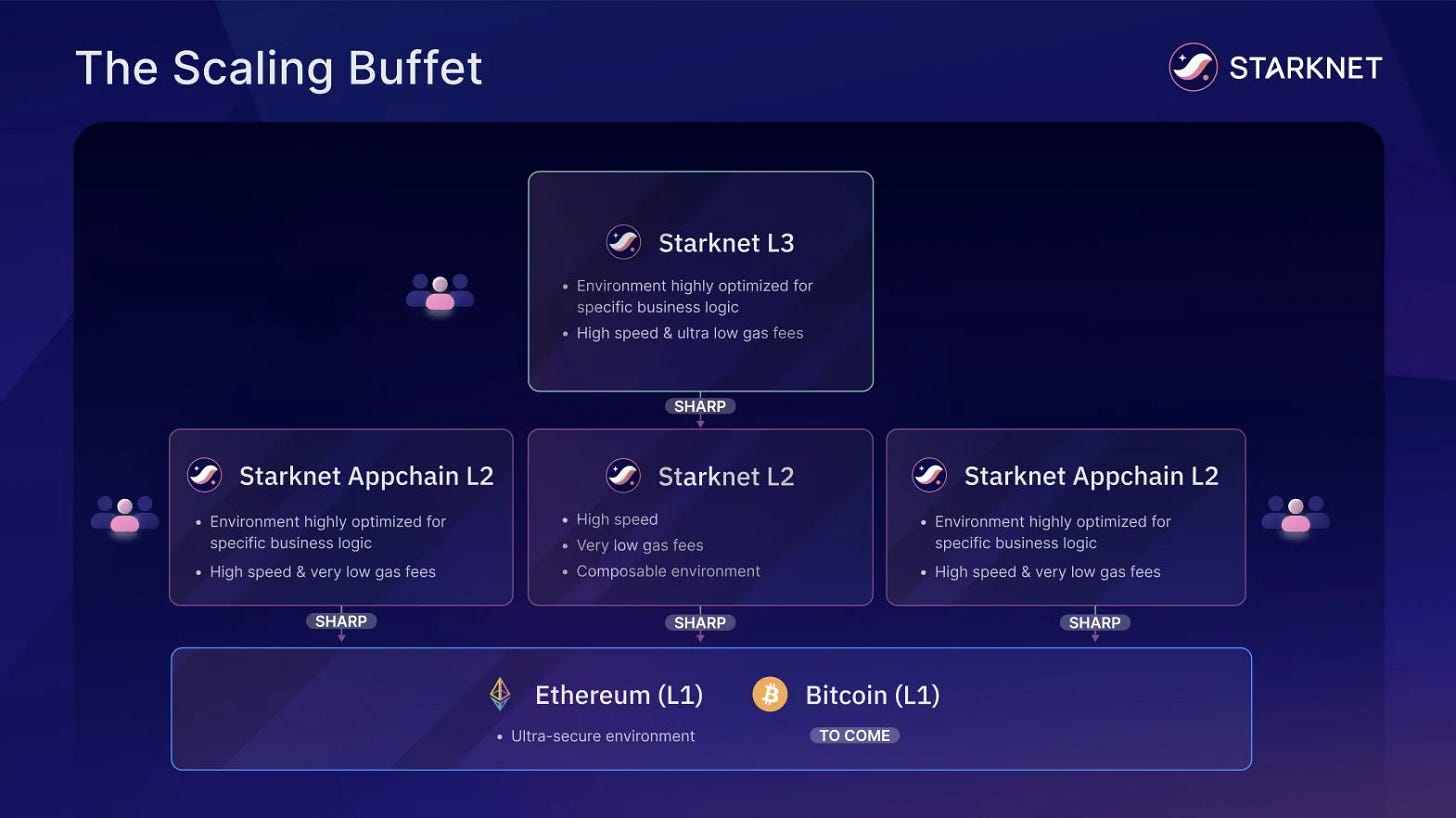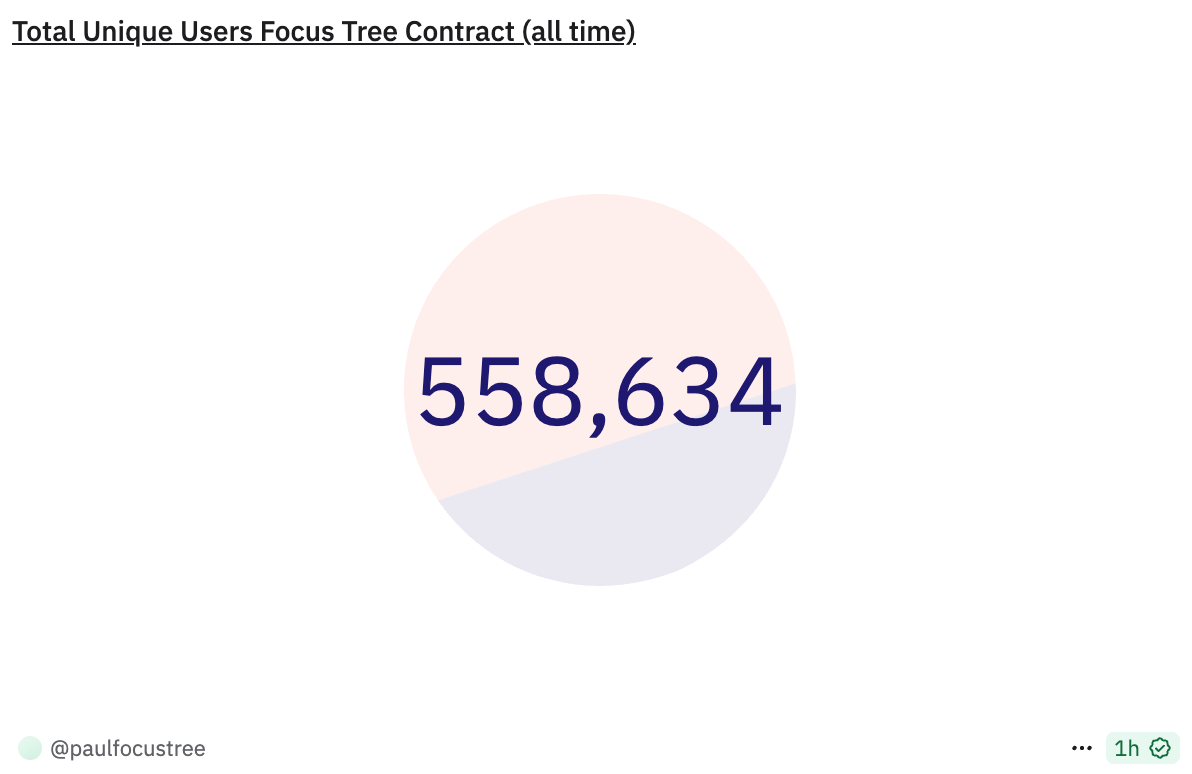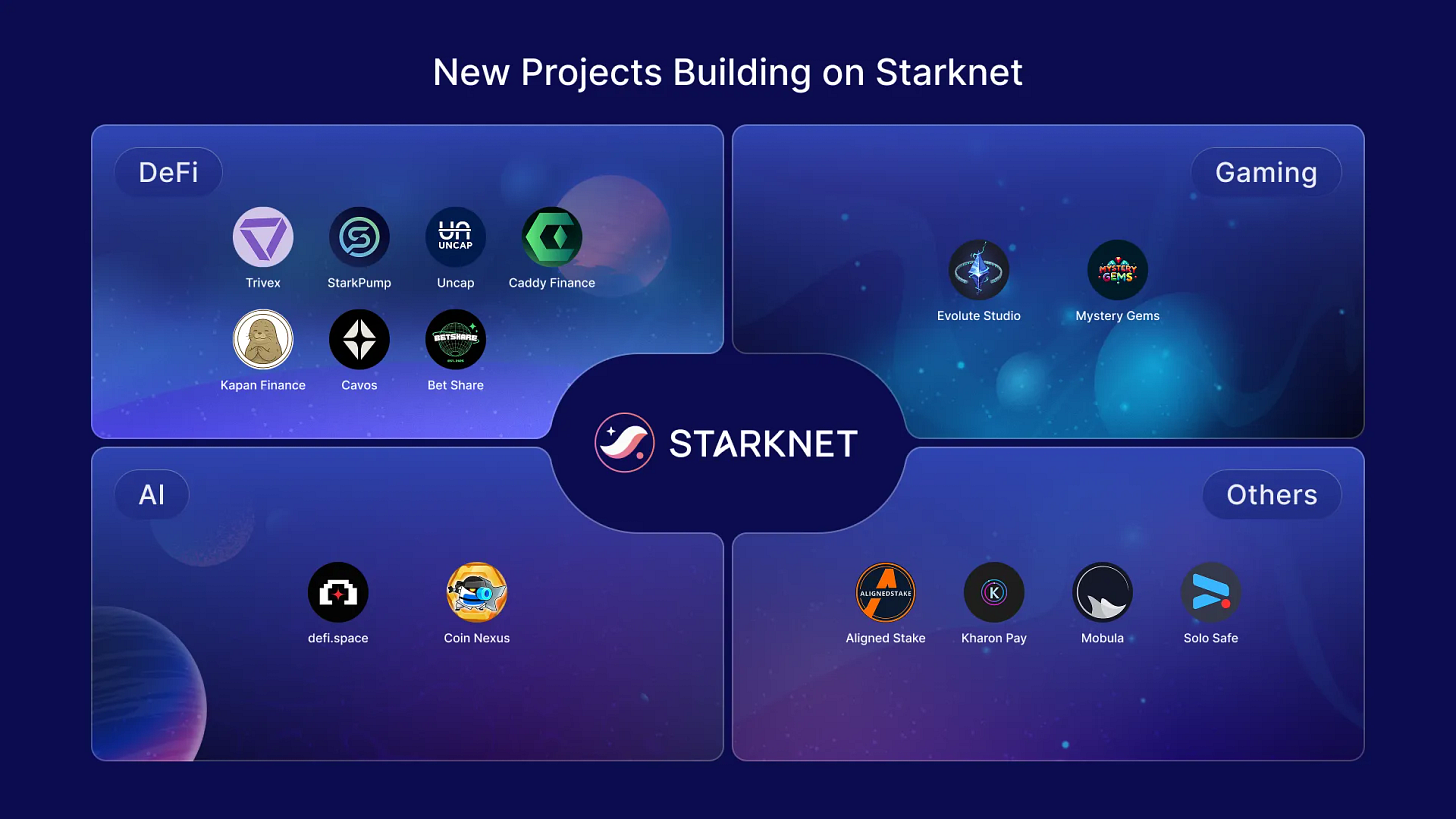Introduction
Scaling never sleeps.
Between performance upgrades, STRK staking, new DeFi projects, and massive user onboarding, Starknet had a busy spring.
This Q2 recap walks you through what shipped, what’s coming next, and why Starknet is still the most ambitious L2 out there.
I. Bitcoin: real use cases, real integrations, real momentum
While most L2s flirt with Bitcoin narratives, Starknet is quietly building the stack to become Bitcoin’s execution layer, alongside Ethereum.
In Q2, this vision shifted from thesis to reality. Bridges are live, BTC is productive, Runes are usable, staking is coming, and both StarkWare & the Starknet Foundation are shipping on all fronts.
Here’s what happened.
a. The rails are live
The first layer of Bitcoin integration is simple: moving BTC into Starknet. And this quarter, the ecosystem delivered.
Garden Finance, an intent-based bridge, now supports BTC transfers to Starknet from Bitcoin, Ethereum, Arbitrum, Base, Berachain, and Hyperliquid.
Atomiq Labs enables direct BTC swaps between Bitcoin and Starknet.
Layerswap now supports BTC <> Starknet bridging, with Starknet being one of only two chains supported (alongside Ethereum).
Runes Bridge also went live, enabling users to bridge Runes from Bitcoin to Starknet. Currently, only the five largest Runes are supported, but more can be added based on community demand.
These rails are removing major friction for onboarding Bitcoiners to Starknet, and there's much more coming.
b. From static to productive: Bitcoiners in DeFi
While the BTCfi campaign hasn't launched yet, BTC on Starknet can already be put to work:
wBTC is now incentivized through DeFi Spring, with ~4% APR on lending markets like Vesu and Nostra.
Braavos launched a One-Click Earn flow: bridge, wrap, lend, done, all in one-click.
DOG, the top Rune on Bitcoin, is now fully integrated into Starknet DeFi:
Tradable on AVNU, Remus, Layer Akira and Fibrous
You can even use DOG to pay for gas via AVNU’s Paymaster.
Oh, and tBTC is now mintable directly on Starknet, with full integration into Starknet’s DeFi ecosystem currently underway.
To push things even further, long-time Bitcoiner and degen Jack Liu has joined the mission. He now leads a $2M fund focused on building consumer-facing Bitcoin apps on Starknet, accelerating the BTCfi movement from the front lines.
c. Asset Runes: new primitive, new possibilities
Q2 also marked the launch of Asset Runes, Bitcoin-native tokens that offer 1:1 exposure to Ethereum assets while staying minted on Bitcoin.
The first one is USDC: minted on Bitcoin, redeemable anytime on Starknet.
On Bitcoin, you can trade or provide liquidity on DotSwap, or trade them on Magic Eden.
USDC Runes can be bridged back to Starknet via StarkGate at anytime.
More Asset Runes are coming: ETH, STRK, RWAs, NFTs…
d. Research & infra: ColliderVM, Broly, and staking
On the research side, StarkWare introduced ColliderVM, a major improvement over BitVM:
No 7-day fraud window
No fully collateralized withdrawals
Faster, more efficient, trust-minimized computation on Bitcoin
This is still in the research phase and far from production-ready. But it reflects StarkWare’s long-term commitment to scaling Bitcoin and turning Starknet into a Bitcoin execution layer, following the most trust-minimized path possible.
In addition to ColliderVM, StarkWare also released Broly, a proof of concept that lets users inscribe Bitcoin directly from a Starknet wallet, using a mechanism similar to storage proofs. It’s open-source and ready for developers to build on.
Finally, Bitcoin staking is expected to arrive on Starknet in Q3 2025. It will unlock three key benefits:
Sustainable rewards for BTC holders
Increased security for the Starknet network
A powerful new primitive for developers to build on
You can learn more in the official SNIP. Note that while BTC will become a stakable asset on Starknet, at least 75% of the staking power will still be driven by the STRK token, and a BTC/STRK alignment mechanism will balance incentives.
All of these Bitcoin integrations are laying the groundwork for the upcoming BTCfi campaign, which is set to launch in the coming months. Bitcoin on Starknet is still early, but it’s definitely real.
II. Network & Infra: faster UX, cheaper proofs, and a path to Stage 2
The infra vision behind Starknet has always been ambitious: lower fees, faster UX, and full decentralization, all without shortcuts or compromise.
In Q2, the ecosystem kept executing toward that vision, one upgrade at a time.
a. The engine under the hood: performance & network upgrades
This quarter marked a turning point for Starknet, with protocol upgrades that reinforce the foundation for everything that’s coming next.
v0.13.6 went live on Mainnet in early July. On paper, it’s a minor release. In reality, it lays the groundwork for S‑two integration, StarkWare’s new prover that will soon supercharge proving performance across the entire network.
v0.14.0, already live on testnet and scheduled for Mainnet in August, is the real milestone. It brings:
- A new sequencer architecture: 3 independent sequencers using Tendermint-style consensus, a major step toward decentralized sequencing.
- Pre-confirmations: UX finality drops from ~2s to just 500ms for most actions (swaps, LPs, lending, etc.)
- Block time: reduced from 30s to just 4–6s
- Fee market + mempool: transactions are now prioritized by tip (like Ethereum), providing a more predictable UX and preparing the ground for the upcoming STRK fee burn mechanism
- STRK becomes the only native gas token, but Paymasters like AVNU and Cartridge let users pay gas in other tokens
- For devs, it introduces some breaking changes, make sure to review the details.
b. S‑two: the fastest prover in the world
StarkWare’s new prover, S‑Two, is now available to everyone, and it’s a monster. Across all zk benchmarks, it outperforms the competition.
In fact, S‑Two is the first prover to make client-side proving viable in real-world apps. And some projects are already putting it to work:
Paradex is integrating it to enable privacy-preserving trading
Nexus is leveraging it for provable compute in Rust, C, and RISC‑V
Kakarot aims to bring real-time proving to everyday devices, while adding ZK diversity to Ethereum L1
And Starknet itself will soon adopt it. The S‑Two MVP is expected to reduce proving time from 24 minutes to under 3, while cutting costs by 2x.
This marks a major leap forward for Starknet performance. And it’s only the MVP.
c. Starknet is now a Stage 1 ZK Rollup
In May, Starknet officially reached Stage 1 on L2Beat, becoming the first pure ZK Rollup to get there.
What does that mean?
Stage 0: centralized infra, data posted on L1
Stage 1: operators replaced by contracts, permissionless exits, multi-party verification, constrained security council
Stage 2 (coming): full trustlessness, Ethereum-grade guarantees
You can dive deeper into the Stage 1 criteria here.
Now that the training wheels are off, the Starknet ecosystem is doubling down on becoming a Stage 2 rollup as soon as possible.
Starknet will soon run faster, feel faster and prove faster on Mainnet. And it’s doing it all while pushing decentralization forward.
III. Staking v2: toward economic decentralization
Speaking of decentralization, staking is the cornerstone of Starknet’s transition toward a fully decentralized network. And in Q2, real progress was made with the rollout of Staking v2, introducing a new layer of validator responsibilities and incentives.
Indeed, staking v2 went live on Mainnet in June, bringing two major improvements over Phase 1:
Validator Block Attestation: Starknet now operates in epochs. During each epoch, validators must attest to randomly selected blocks. If they don’t, they lose their rewards, and so do their delegators. This improves transparency and ensures validators are active before full consensus duties arrive.
Commission Changes: Validators can now increase their commission, but only under strict conditions. This adds flexibility without sacrificing fairness.
These upgrades make validator behavior more accountable and visible, both for the protocol and for delegators.
As of current metrics (as of July 22):
430M STRK staked on Starknet
~12% of the circulating supply
119/151 actively attesting to blocks
You can track all these metrics in real time here.
Note: both StarkWare and the Starknet Foundation have launched their own delegation programs, meaning they are delegating their STRK to external validators.
The good news? You can apply to both programs at the same time: StarkWare Delegation Program (round 2) and Starknet Foundation Delegation Program.
IV. Builders, L3s, and full-stack creativity
Starknet isn’t just scaling throughput, it’s also scaling what’s possible for developers.
In Q2, the ecosystem shipped new primitives, tools, and grant programs that open up fresh design space across L2, appchains, and L3s.
a. The L3 building block is now available on Starknet
In April, Karnot launched a 14-hour ephemeral L3 called Gridy, built on top of Starknet. This short-lived “gamechain” proved that L3s on Starknet are now fully viable, and extremely efficient.
Sustained 220 UOPS, peaking at over 400 TPS
But the real unlock was the full abstraction of the L1 → L2 → L3 flow that Karnot delivered. No matter where you were (Ethereum L1, Starknet L2, or the Gridy L3) you didn’t need to download a new wallet, bridge funds, or switch networks. You just… played. Directly. Seamlessly. That’s what blockchain UX is supposed to feel like.
With this, Starknet now offers builders a composable stack with multiple flavors:
Starknet L2: maximum composability
Starknet L2 appchains: flexibility + autonomy
Starknet L3s: hyperscaling and use-case-specific adaptation
Pick your layer, launch your project, abstract the pain, and scale your business.
b. Dev on Starknet… without writing a single line of Cairo
Cairo Coder is now live, a new tool from Kasar Labs that lets anyone generate Cairo contracts and programs directly from Cursor, their AI-assisted IDE.
It’s fully compatible with the Starknet dev stack and always up to date with the latest tools and features.
With Cairo Coder, you can now build whatever you want using Cairo, the most powerful and flexible provable language out there, without writing a single line of it.
So, whatever you have in mind: just build. Starknet handles the rest.
Here’s a real example of what devs are already building with it.
Want to try it? Start here.
c. Builder support is scaling too
The Starknet Foundation has launched two new initiatives to help projects start, grow, and thrive on Starknet:
Propulsion v2: covers gas fees for eligible dApp users (up to $1M total).
Payments Builder Grants: STRK grants for teams building payment-related projects, with support for user acquisition and traction.
The goal? Help good ideas go from 0 to live, and remove the friction along the way.
Devs (and non-devs) now have everything they need to build whatever they imagine, find PMF, and thrive on Starknet. Time to build.
V. Extended: a next-gen Perp DEX goes native on Starknet
One of the biggest unlocks in June? Extended, a high-performance Perp DEX, announced its migration from StarkEx to Starknet L2, and it’s happening this summer.
Extended is arguably the most complete Perp product ever launched on Starknet. Think: Hyperliquid-level UX and features, but built natively on Starknet. The team behind Extended includes ex-Revolut builders, bringing TradFi-grade execution into crypto-native DeFi.
In short, Extended is bringing to Starknet:
Perp trading with up to x100 leverage
50+ assets, including crypto pairs and TradFi markets (Gold, S&P500, Nasdaq, Brent, EUR…)
A community vault yielding ~22–30% APR in USDC for LPs
An active XP campaign (Season 1 already live)
Full EVM wallet support: MetaMask, Rabby, Phantom, and more
Their migration plan is already live, and the protocol is set to launch on Starknet Mainnet by late July or early August. Everything has been designed for a seamless transition for existing users.
In my humble opinion? This is the biggest DeFi launch on Starknet since Ekubo and Vesu. And it’s exactly the kind of flagship product Starknet needs as its L2 liquidity layer matures.
VI. Focus Tree: Starknet’s stealth onboarding machine
What happens when you combine TikTok virality, invisible UX, and native Starknet infra?
You onboard over 500,000 blockchain newbies, without them even realizing it.
In Q2, Focus Tree launched a fully onchain wallet experience designed for people who have never touched crypto before. No gas fees, no seed phrase, no wallet popups, no network switching, just seamless, invisible onboarding.
This is made possible by:
The result? Almost 550k new users on Starknet, all coming from a non-crypto, gamified learning app.
And this is just the beginning. Focus Tree plans to progressively expand what these users can do onchain, new missions, deeper social mechanics, and more DeFi-like actions.
VII. Appchains on Starknet: from vision to execution
Starknet’s appchain thesis is shipping fr. In Q2, three new projects announced they’re building with the SN Stack, Starknet’s modular appchain framework:
StarkPay: private payment infra for real-world usage
Forge Agent: an AI agent marketplace where anyone can create, hire, or monetize autonomous agents
Eara: a compliance-first backbone for tokenized RWA trading in Europe
All three projects are part of the Karnot accelerator, a program designed to help teams launch Starknet-powered appchains and scale them from zero to production.
And Karnot itself just hit a major milestone: 7,000 tps settled on Ethereum using the SN Stack, a live demo of Starknet’s scaling potential.
Meanwhile, Paradex, the first (and only) live Starknet appchain, kept shipping relentlessly in Q2:
Gigavault cap raised to $30M: a fully protocol-owned liquidity vault earning from MMs, funding spreads, liquidations
Mobile app launched on iOS and Android
85%+ of the codebase audited by Cairo Audit
The team also revised its tokenomics to better align incentives, with Paradigm’s 13.4% allocation vesting linearly based on long-term performance, not time-based cliffs.
The Paradex momentum is not stoping anytime soon. Here what’s coming next and when.
VIII. The Wolf Pack League is now open to everyone
StarkWare recently opened the gates to the Wolf Pack; a new contributor program that lets anyone help grow the ecosystem and earn rewards for it.
Whether you’re a content creator, dev, designer, or just passionate about Starknet, the Wolf Pack League gives you a direct path to contribute and get noticed. And it’s not just about users, projects can also publish bounties to recruit talent from the Starknet community.
In a nutshell, Wolf Pack League is an all-in-one platform:
Projects get visibility and support
Contributors earn rewards and build onchain reputation
Starknet grows stronger.
Everyone win with it.
IX. Social login and EVM wallets: onboarding is getting smoother
Cartridge rolled out its first social login, letting users create a Starknet wallet using just their Discord account, with more login options (Google, X…) coming next. But that’s not all. EVM wallet compatibility is also live. You can create a Cartridge Controller and interact with Starknet using MetaMask, Rabby, Phantom, and other EVM wallets, no extra setup required.
And coming next: Rosettanet, a project designed to make EVM wallet compatibility native on Starknet, is expected to go live in the coming weeks.
X. Other Highlights This Quarter
Here’s everything else that dropped this quarter:
Endur launched a points program + revenue airdrop for early xSTRK users
Ready launched the Ready Lite Card, spend your Starknet assets IRL with 0.5% cashback, no fees
Cavos is building a virtual card to spend Starknet assets anywhere
AAVE, POL and UNI are tradable on Starknet via Layer Akira, AVNU, and Fibrous
Blob Arena launched during a major IRL sports event: Starknet gaming goes public
XI. New launches on Starknet Mainnet
DeFi
Stormbit: a lending/borrowing protocol offering up to 99% LTV with no liquidation
Forge Yields: a cross-chain yield farming protocol
Curvy: a privacy-focused protocol
Ponziland: an onchain strategy game where players buy, sell, and manage land
Gaming
Atemu: a card-based game on Starknet.
Lutte Arcade: a lootverse battler
Pistols: a 1v1, fully onchain dueling game
Crimson Fate: a fully onchain rogue-like gaming project
Blobarena: a Pokémon-like game with a real-world-integrated universe (AMMA)
Metacube: a Minecraft-inspired mini-game
Starknet Arcade: a fully onchain casino
Payments
Copperx: a payment protocol enabling to pay users, vendors, or partners instantly in stablecoins on Starknet
Request Finance: a platform for handling crypto and fiat operations
OneRamp: a payment platform focused on Saharan Africa
Other
Karat: a new NFT collection.
Wolf Nation: a brand new NFT collection
OnChainGM: say “gm” onchain (yes, it costs 0.5 STRK to say gm now)
Coloniz: a fully onchain social network, similar to Twitter and Patreon
XII. New projects building on Starknet
DeFi
Trivex: a Perp DEX + strategy analytics platform
StarkPump: a new token launchpad
Uncap: a Bitcoin-backed stablecoin inspired by Liquity
Caddy Finance: one-click yield vaults for Bitcoiners
Kapan Finance: a debt refinancing protocol
Cavos: a mobile focused DeFi application
Bet Share: a prediction market for sports events
Gaming
Evolute Studio: a gaming studio building three different games
Mystery Gems: a GameFi project
AI:
Coin Nexus: a gaming x AI project
defi.space: an arena for AI agents
Other
Aligned Stake: an analytics platform for STRK staking
Kharon Pay: a new crypto payment protocol
Mobula: a full-stack data infrastructure provider
Solo Safe: a tool for offline asset transfers
XIII. What’s next?
The second half of 2025 is shaping up to be pivotal for Starknet, from major product launches to long-awaited decentralization milestones.
Here’s a glimpse of what’s coming next:
BTCfi campaign launch (likely in September): finally bringing a tailored incentive campaign designed for Bitcoiners
Bitcoin staking (Q3): more security for Starknet, a new yield opportunity for BTC holders, and a new DeFi primitive on Starknet
Xverse wallet full integration (Q3-Q4): bringing the leading Bitcoin wallet into the Starknet DeFi and gaming stack
LBTC integration (Q3): Bitcoin’s top liquid staking token is coming to Starknet
2 major interoperability projects (Q3 - Q4): not yet public, but integrations are underway
Rosettanet (Q3): enabling native EVM wallet compatibility across Starknet
New social login options (Q3-Q4): for even smoother onboarding experiences
Extended (in a few weeks): a Hyperliquid-style Perp DEX launching on Starknet Mainnet
Starknet v0.14.0 (August): introducing decentralized sequencing, mempool, fee market, pre-confirmations, and more
Staking v3 (EOY): validators will now attest and vote on sequenced blocks, another step toward full decentralization
S‑two integration on Starknet (Q3-Q4): massive performance leap for proving; unlocks new use cases like side-client proving
STRK burn mechanism (via fees): coming but no precise timeline yet
Staking v4 (H1 2026): the final milestone of staking on Starknet, providing full decentralization of the sequencer and prover stack
Conclusion
Q2 wasn’t just about metrics, milestones, or product drops. It was about: watching a bold roadmap slowly come to life.
Bitcoin is becoming a first-class citizen. Appchains are shipping. New primitives like client-side proving, asset runes, and BTC staking are going from theory to production. Builders are showing up. UX is becoming invisible. And decentralization is no longer a meme.
Starknet is building a new layer of the internet. One where Ethereum and Bitcoin finally scale. Where devs can build without compromise. And where users don’t even need to know they’re using blockchain.
The foundation is set. Now comes the breakout phase.
None of the content of this newsletter is financial advice. Always do your own research.


